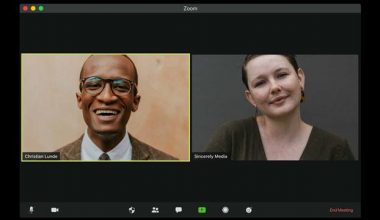
The COVID-19 crisis has driven a transition to online meetings and remote learning as many organizations look to balance work and professional development between home and traditional offices. We don’t know yet whether the new shift to virtual work will become a lasting solution, but it raises important questions about learning effectiveness.
Virtual education has been with us since the turn of the 21st century, when the term “eLearning” was introduced. Preceding it was computer-based training (CBT), which gained traction in the 1980s yet was too often focused on giving information rather than real learning.
That same problem is what worries me about this headlong sprint into virtual learning — not that it can’t be educationally sound but that technology will marginalize the instructional design. In fact, now that online communication and training platforms have become the center of our lives, I see more comments on lighting, backgrounds and how to position the computer than the quality of what people are delivering over those platforms.
Levels of Learning
The question any educator or presenter should ask is, “What do I want the audience to be able to do as a result of this presentation or training?” If the answer is “a general understanding of the topic,” then the design is straightforward and can be delivered in a lecture over a virtual platform. Benjamin Bloom referred to this type of knowledge as simple knowledge, the lowest rung on his taxonomy of learning.
If, however, the expectation is higher-order learning and behavioral or organizational change (Kirkpatrick’s levels 3 through 4, for instance, or Bloom’s ability to analyze, synthesize and evaluate), the design needs to be more sophisticated and engage learners in application.
The Virtual Challenge
How do you achieve higher levels of learning over a virtual platform? There are several options: Firstly, you can create an eLearning product. New software has made this option more accessible and less expensive for everyday users as well as vendors. The problem is that it takes time and money to pull together an eLearning course, especially if it is well designed and interactive.
Secondly, you can deliver lectures over virtual teleconferencing platforms. The challenge here is that online lectures are no different than lectures delivered in amphitheaters: They are one-dimensional and often not compelling. Ask any college student — or, these days, any online elementary school student.
The Action Learning Opportunity
There is some good news about the COVID-driven trend toward online education: Work and learning are continuing in the midst of unprecedented disruption, and forward-thinking meeting sponsors and curriculum developers are taking full advantage of the new technology and openness to online education.
Will we be able to drive behavior change and organizational impact online? Will we ever reach the top of Bloom’s pyramid? Action learning has the potential to take skill-based virtual education — eLearning or virtual streaming — to the next level. Here’s how.
8 Steps to Implement Action Learning Online
Psychologist Reg Revans developed the concept of action learning in the early 1950s while working with the British Coal Board. He discovered that by giving leader cohorts a problem and then systematically debriefing them with open-ended questions and reflection opportunities, he could engage them more organically in their own learning and prompt personal and organizational breakthroughs. Revans’ formula (Learning = Programming + Questioning + Refection) has become a cornerstone of outstanding instructional design.
Unfortunately, even though action learning programs have become a staple of corporate education, they are not always delivered with high quality. At their best, they drive higher-order learning and solve real business problems. At their worst, however, they involve nothing more than scenario-planning and flip-chart presentations inside routine leadership programs.
I am optimistic that action learning will receive a boost from the virtual environment we are living in and lead to more dynamic business events and corporate education. To give it that boost in your organization, here are eight steps to implement action learning in a virtual environment:
Step 1. Identify the Underlying Context of the Presentation or Training Session
Every learning objective or business topic has some organizational context wrapped around it; you just have to look for it. Asking why the topic or skill is challenging will reveal the context. Perhaps the sales training has become more difficult because COVID-19 has caused the market environment to be in flux. Maybe the monthly “state of the business” presentation has become an eye-roller because of its complexity, reporting requirements and overall length. Once you uncover the context, you can fold the skill or business objective into a holistic virtual solution.
Step 2: Turn the Context Into Subgroup Projects
Next, create a set of subgroup projects that embrace both the learning objective and the context for acquiring the skill. For example, identify subgroup projects that drive understanding of a targeted sales skill, like forecasting in market segments that have been more profoundly affected by the virus. Design a series of breakout meetings for the “state of the business” presentation that drives greater engagement and asks attendees to do something specific and valuable with the data, like spotting trends or identifying opportunities.
Step 3: Require Online Discovery and Analysis
The best training programs and the best business meetings have a common thread: They engage the audience intellectually and analytically. They force the audience to gather and think about data, not just perform a series of rote tasks.
The virtual platform, then, is a natural complement to this best practice. Challenge virtual learners to do online discovery and analysis about the skill or business topic that is the subject of their course or discussion — for example, using data science and predictive analytics to forecast service or product demand post-COVID, rather than relying on fluctuating market reports.
Step 4: Leverage Video Technology
Presenters and instructors are just now picking up the tricks of the trade associated with successful virtual training or meetings. Here are some basics:
Ask a colleague to manage the chat room and sequence the questions.Remind the audience about muting protocols at the start of the session.Send your slides and meeting process or agenda to the audience in advance.Use poll features at key junctures to gauge understanding and receptivity and to prompt questions.Actively manage the technology and connectivity; you will lose the audience more quickly with awkward technical facilitation and poor connectivity than bad content.
Step 5: Engage the Audience
Whether you are teaching a skill or presenting a business topic, it is critical to reach out to the audience, especially in a virtual environment. Single out individuals or cohorts to stimulate interaction, even if you are presenting in front of a large audience (e.g., “What’s your perspective on that point, Susan?”). A single audience question will dramatically spike audience engagement.
Likewise, for action learning cohorts, facilitators should encourage teams to video-chat their colleagues and develop online projects and recommendations. The very act of developing a prerecorded and media-rich presentation will elevate the learning.
Step 6: Assign Coaches to Online Action Learning Cohorts
Revans wanted action learning participants to arrive at insights with a modest amount of facilitation, so he emphasized personal reflection over third-party interventions. Since then, action learning advocates have highlighted the value of facilitators and coaches to stimulate “Aha!” moments, especially given the busyness and distractions of our current working environment.
Coaches who ask good questions are invaluable contributors to individual and team learning. Moreover, assigning a coach to a cohort in a virtual environment is not only cheaper than in a classroom but is also a great way to integrate new or less experienced coaches.
Step 7: Balance the Action With the Learning
The appeal of action learning is different for business executives and educators. Leaders tend to be more interested in action learning project results, while trainers tend to focus on the insight and behavioral breakthroughs that they can create. As a learning and development (L&D) leader, it is important for you to focus on both. While it is critical to make the final action learning presentations and recommendation compelling in front of a virtual audience, it is equally critical to ensure that individuals and teams learn from the experience. Coaches will ensure the action and learning are balanced with virtual one-on-ones and group meetings.
Step 8: Make It Sustainable
Action learning delivers a return on investment (ROI) if the projects are implemented and the learning is reinforced. Once again, the virtual platform makes this process easier than ever. At the conclusion of most classroom-based training, trainers receive an “out of sight, out of mind” reaction from both the program sponsors and participants. With virtual learning, trainers are never out of sight. Capturing value from action learning initiatives is as simple as setting up agile project teams and creating implementation schedules. The sustainability of leadership or functional skills is supported by the continued opportunity to practice those skills on projects and with learning cohorts.
Here to Stay
Virtual learning is here to stay, regardless of the progress we make in eradicating this terrible virus or dealing with other societal disruptions. To turn lemons into lemonade, we must take advantage of video technology with a strategic perspective. Action learning can help us ensure that education will be high-impact and well-designed — and not sacrificed by our enthusiasm for the technology.






